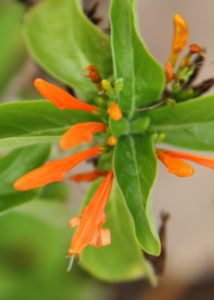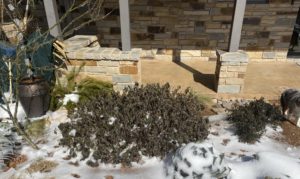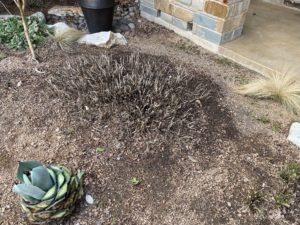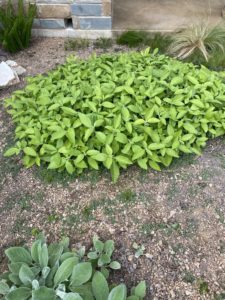
Mexican Honeysuckle – a first responder from the 2021 Winter Storm in Kirk’s garden.
Protective Covering Not Enough
I have a lot of Mexican Honeysuckle (Justicia Spicigera) scattered around the front of my house. Too much, in fact that I couldn’t cover it all in anticipation of February’s storm. So, I chose to protect one of the largest patches near my front door. It was nearly four feet tall and six feet wide. I covered it with a tarp and weighted the corners down with large rocks.

Figure 1-0221. A mushy mess was uncovered once the storm passed.
That turned out to be futile. When I uncovered it, the damage was evident. (Figure 1-0221). It was a mushy mess. But, rather than ripping it out immediately, I followed the Texas A&M Forest Service recommendation and left it in place to see what would happen.
Do You Smell That?
A couple of weeks later, the rotting plant material was stinking up the garden. And, there were no obvious signs of life. Still, I wasn’t prepared to dig it up.

Fig 3-0421. Dead foliage was cut back to the ground.
Nurseries were hit hard, too. They didn’t have any replacement plants. So, I cut it back to ground and waited for spring. (Figure 2-0321).
Rapid Rejuvenation
It wasn’t a long wait. Incredibly, it began to green-up almost immediately. I swear you could see it grow every day. All I did was water it on a regular schedule. Exactly five weeks after the haircut, the plant was over one foot tall and three feet wide. Looking strong and healthy. (Fig 3-0421)

Fig 3-0421. The first responder in Kirk’s garden.
It continued to grow, even blooming a little in the summer. I even dug up a few shoots to plant elsewhere in the garden. By September, it was just about completely restored at three feet tall and six feet wide.
When I cut it back this winter, most of the main stalks were bigger around than lead in a pencil. Healthy and strong.
I lost a lot of plants in freeze. Most of those that made it took seven to eight months to partially recover — some won’t be fully recovered until this spring. The Mexican Honeysuckle was presentable in a mere seven weeks. Since I had it various spots in the garden, it was the first sign of hope no matter where you looked. In less than seven months it was essentially completely recovered. Turns out, it didn’t need protecting.
This spring I’ll be dividing more of it to add to my back garden, which the butterflies will love!
Additional Resources
Kirk is participating in the Travis County Master Gardener Winter Storm Project.
Weather Strategies for Austin Gardens
Native and Adapted Landscape Plants searchable database
Climate Graph for Austin Bergstrom
About Kirk Walden

Kirk is a hands-on experiential gardener. While he appreciates the cerebral aspects of gardening, he revels in the visceral experience of digging in the dirt. When he moved to Austin in 1998, the home had virtually no landscaping, mostly just limestone and cedars. His determination to beautify it led to an avocation as a serious gardener that culminated in Travis County Master Gardener Certification in 2014.
